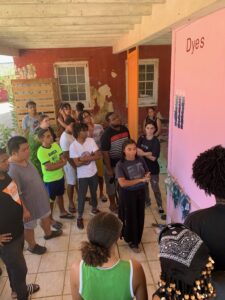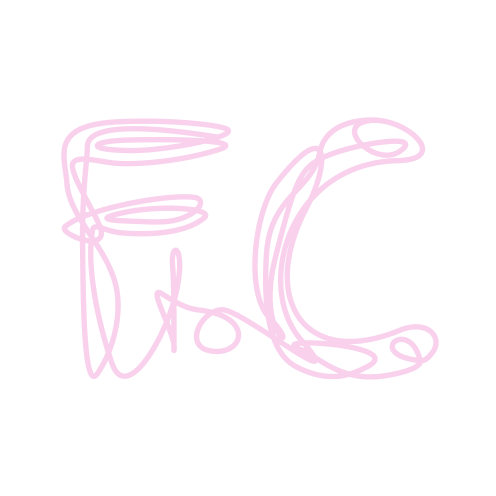The 1, 2, 3 method of botanical dyeing
Loret Karman was conflicted when she received Farm to Crafts’ invitation to teach about botanical dyes. She wondered if she, a white woman, was the right person to share her knowledge about indigo. The history of the blue dye is deeply tied to slavery. “In the end I am very happy to have witnessed how the team works. My two weeks in Curaçao were a mutual exchange of knowledge and experience.”
Together with her assistant Myra Scholma, she set up a dye studio at Hòfi Cas Cora for two weeks. During the first weekend, on September 9th and 10th, a group of fashion and product designers, textile enthusiasts, and individuals interested in cultural heritage participated in the indigo masterclass. Afterward, they delved into the fascinating world of botanical dyes. The Curaçaoan landscape turned out to be rich in plants from which dyes could be extracted.
Step 1
On the first day, the indigo dye is prepared from the plant’s sap. Curaçao has two types of indigo plants, indigofera tinctoria and indigo suffruticosa. Both plants look almost identical, with the main difference lying in the seed pods. Indigo suffruticosa has curved pods, while indigo tinctoria has straight pods. The leaves contain the colorless indican, which is enzymatically split into glucose and indoxyl, with the latter substance transforming into indigo through air oxidation.
This process is explained step by step by Loret, assisted by Guenna Gustina, who experiments locally with natural dyes. First, the collected indigo is cut into pieces. “We want to obtain every piece of pigment. We don’t let anything go to waste,” says Loret. The branches, leaves, and pods are carefully weighed. Out of the 19 kilograms of indigo plants, almost one kilogram remains for the dye bath. “We need to make this more efficient,” says environmental economist Cindy Eman.
An old bathtub from the renovated Kura Hulanda resort is filled with approximately 10 Liters of water, enough to immerse the indigo. The water immediately turns a light brown from the impurities. “This won’t have an effect on the final product,” assures Myra. Then, a black plastic garbage bag is placed on the water’s surface. Heavy stones are used to keep the bag from blowing away. The sun shining directly on the bag boosts the fermentation and decomposition process.

Step 2
While the fresh indigo ferments in the bath for the next 24 hours, the participants immerse themselves in creating three indigo vats. The indigo powder used for this purpose comes from India. Once the Indigo has been fermented it is still insoluble in water. The indigo must undergo reduction, a process of removing oxygen from the dye bath, making the dye soluble. Each vat includes three ingredients: one-part indigo pigment as the source of color, a two-part component to elevate the pH-value, and a three-parts reducing agent to remove oxygen from the dye liquid.
For today’s experiments Loret uses henna, bananas and fructose powder as reducing agents. Calcium hydroxide is the component to elevate the pH-value. Guenna transfers 30-gram indigo powder in a jar containing a few marbles. The marbles are an efficient way to hydrate the indigo. She then pours hot water in the jar, closes the lid and starts shaking the jar carefully. Next, 60 grams of calcium hydroxide are scooped from a bag. Face masks are worn to prevent inhaling the substance as it can cause irritation to the respiratory tract and nasal mucosa. Finally, 90 grams of fructose powder are weighed out. Meanwhile, 4 Liters of water are boiling in a stainless-steel pan.
This process is also repeated with the henna and banana pulp. The bananas are interchangeable with other fruits. “We could also explore whether mangoes, mispel (medlar) or tamarind are suitable options“, says Loret after the participants indicate that these fruit trees leave owners with an oversupply. A significant portion of the overabundance goes to waste.
Step 3
Guenna has added the henna and indigo to the pan of boiling water. She then pours in two Liters of water, bringing the total amount of water to 6 Liters. The next step is adding 60 grams of calcium hydroxide. She stirs gently to prevent extra oxygen from entering. Aluminium spoons are prohibited due to the chemical reaction. “Someone needs to stir the mixture every half hour. An indigo vat is like a baby. It needs constant care”, says Loret. “In Africa, they taste it to determine if it’s right”, Guenna explains. “They have a connection with the material.”
The Coloring
 Day 2. The beauty of Indigo dye is in the unpredictability of the results. As the cloth is pulled from the vat it appears green until exposure to the air oxidises the dye and turns it blue. Each time the cloth is dipped and exposed to the air the shade of blue gets deeper. The colour achieved depends on the type of vat used and the number of times the fabric is dipped. Darker indigo shades are achieved with multiple dips rather than a stronger dye bath.The same result can also be seen with the threads and various types of materials being dyed. Everything is meticulously recorded. Silk, linen, cotton, the type of henna vat, and the number of dips are all noted. This continued throughout the rest of the week as the participants worked with turmeric, cochineal, “dushi di kabei”, “brasia”, “divi divi”, cutch of cachou (related to the wabi), sorrel, and “appeldam.”
Day 2. The beauty of Indigo dye is in the unpredictability of the results. As the cloth is pulled from the vat it appears green until exposure to the air oxidises the dye and turns it blue. Each time the cloth is dipped and exposed to the air the shade of blue gets deeper. The colour achieved depends on the type of vat used and the number of times the fabric is dipped. Darker indigo shades are achieved with multiple dips rather than a stronger dye bath.The same result can also be seen with the threads and various types of materials being dyed. Everything is meticulously recorded. Silk, linen, cotton, the type of henna vat, and the number of dips are all noted. This continued throughout the rest of the week as the participants worked with turmeric, cochineal, “dushi di kabei”, “brasia”, “divi divi”, cutch of cachou (related to the wabi), sorrel, and “appeldam.”
The whole community was invited to admire the results on September 16th. Various shades of blue, yellow, and red/purple adorn the wall. According to Loret, this shows that you can extract primary colors from natural resources in Curaçao. The color expert mentioned that the 35 participants felt closer to nature during the workshops. The beauty of the colors also sparked a protective instinct in them. “In the beginning, we mostly created earthy colors, even with the henna. It was only after a few days, when we extracted dye from the brasia, that we felt a new wave of excitement”, says Cleo de Brabander. The wood from the brasia produces an intense purple color. A craving for more purple emerged. Then it dawned on us. The greed we felt must have been experienced by the colonizers as well. That’s why it became a hype in the 16th and 17th century. In the 19th century exports from Curaçao were much reduced, probably as a result of overexploitation. The brasia is a slow-growing tree. It takes at least 70 years before the tree is fully grown. Emotions ran high during the discussions. There were suggestions to keep the color a secret but also to introduce laws for the protection of the brasia and to start a tree nursery. By the way, the core of the trunk used in the workshop was imported from Haiti. No local trees were felled for this project.”
Dark Side of Indigo Cultivation
Together with environmental economist Cindy Eman, Loret embarked on a journey through the mondi (natural areas) of Westpunt. “We arrived at the indigo bassins that were used during slavery. It was emotional. It’s one thing to read about it, but to see it in real life. Wow, it still brings tears to my eyes. I could visualize the cruel forced labor. How the enslaved individuals had to pick indigo and make dye baths day in and day out under the scorching sun. They themselves gained nothing from it. The bassins are far away from the plantation house because of the foul odor. The story goes that those who worked in indigo production couldn’t sleep with the other slaves because of the smell. The odor seeped into their skin. As a result, they were isolated. Nowadays, the working conditions are not any better. I’ve seen films of how they make indigo dye in India. It’s inhumane.”
Loret appreciated that the project provided an opportunity to discuss the darker side of indigo. The idea of reviving this industry stirred conflicting feelings within her. “Indigo cultivation is emblematic of the excesses of colonial times. Literal blood was shed to produce that beautiful blue color. The disastrous effects of this cultivation are virtually unmentioned in colonial records.” In Afro-Curaçaoan culture, there is a tradition linked to indigo cultivation. Newborns are protected from the “evil eye” (oyada) with “blauwsel”. This substance is rubbed on the crown or tailbone. Additionally, the plant is still used in folk medicine under the name ‘Jerba di seis’. In the early 20th century indigo was replaced by synthetic indigo, when it slipped into obscurity.
Indigo is now making a comeback in the States. Travelers to South Carolina can take artisan-led workshops on how to harvest and dye with the plant, and most of all, visit historic sites which explore the ugly past of this beautiful color.
Cochineal
Loret sees opportunities with cochineal. The Canary Islands, with EU support, have revitalized cochineal cultivation. Curaçao shares many similarities with the Spanish islands, both in terms of climate and economy. The cochineal insect feeds on the host plant (Opuntia ficus indica, also classified as Opuntia maxima and Opuntia tomentosa), which was introduced to the Canary Islands before the 19th century and is now a naturalised species on all of the islands on account of its agricultural value for cochineal farming. It is currently recognized by the European Union with the Protected Designation of Origin “Cochinilla de Canarias”, being this archipelago the only European territory where cochineal is produced for commercialization. Coincidentally, Hòfi Cas Cora was one of the plantations in Curaçao that produced cochineal. The nopal cacti has been introduced on the island for the production of cochineal. But it never brought more than modest profit.
Written by Nelly Rosa


